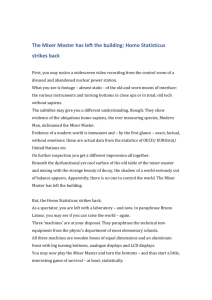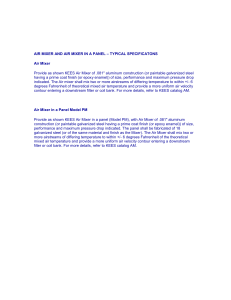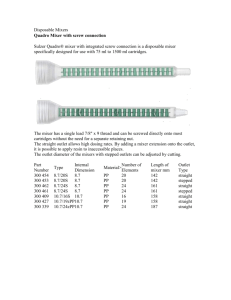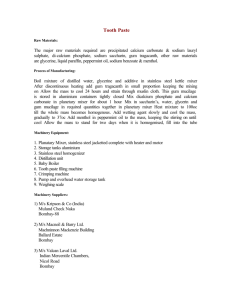Practical Issues Implementing Analog-to-Information Converters
advertisement
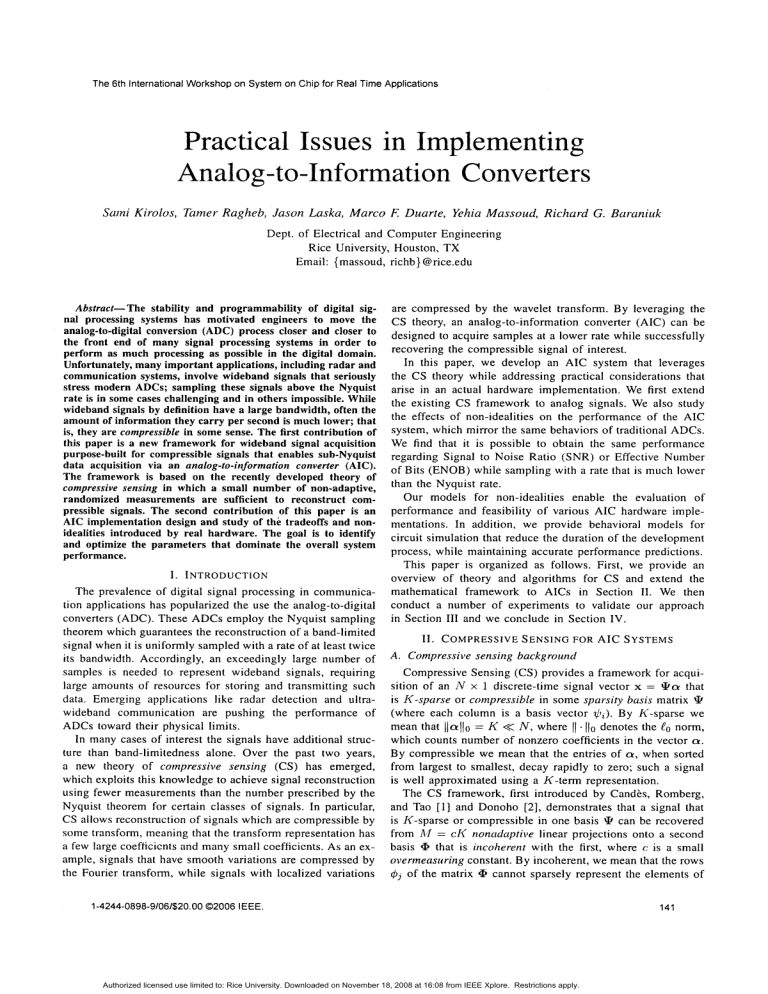
The 6th International Workshop on System on Chip for Real Time Applications
Practical Issues in Implementing
Analog-to-Information Converters
Saini Kirolos, Tamer Ragheb, Jason Laska, Marco
F
Duarte, Yehia Massoud, Richard G. Baraniuk
Dept. of Electrical and Computer Engineering
Rice University, Houston, TX
Email: {massoud, richb}@rice.edu
Abstract- The stability and programmability of digital signal processing systems has motivated engineers to move the
analog-to-digital conversion (ADC) process closer and closer to
the front end of many signal processing systems in order to
perform as much processing as possible in the digital domain.
Unfortunately, many important applications, including radar and
communication systems, involve wideband signals that seriously
stress modern ADCs; sampling these signals above the Nyquist
rate is in some cases challenging and in others impossible. While
wideband signals by definition have a large bandwidth, often the
amount of information they carry per second is much lower; that
is, they are compressible in some sense. The first contribution of
this paper is a new framework for wideband signal acquisition
purpose-built for compressible signals that enables sub-Nyquist
data acquisition via an analog-to-information converter (AIC).
The framework is based on the recently developed theory of
compressive sensitng in which a small number of non-adaptive,
randomized measurements are sufficient to reconstruct compressible signals. The second contribution of this paper is an
AIC implementation design and study of the tradeoffs and nonidealities introduced by real hardware. The goal is to identify
and optimize the parameters that dominate the overall system
performance.
I. INTRODUCTION
The prevalence of digital signal processing in communication applications has popularized the use the analog-to-digital
converters (ADC). These ADCs employ the Nyquist sampling
theorem which guarantees the reconstruction of a band-limited
signal when it is uniformly sampled with a rate of at least twice
its bandwidth. Accordingly, an exceedingly large number of
samples is needed to represent wideband signals, requiring
large amounts of resources for storing and transmitting such
data. Emerging applications like radar detection and ultrawideband communication are pushing the performance of
ADCs toward their physical limits.
In many cases of interest the signals have additional structure than band-limitedness alone. Over the past two years,
a new theory of compressive sensing (CS) has emerged,
which exploits this knowledge to achieve signal reconstruction
using fewer measurements than the number prescribed by the
Nyquist theorem for certain classes of signals. In particular,
CS allows reconstruction of signals which are compressible by
some transform, meaning that the transform representation has
a few large coefficicnts and many small coefficients. As an example, signals that have smooth variations are compressed by
the Fourier transform, while signals with localized variations
are compressed by the wavelet transform. By leveraging the
CS theory, an analog-to-information converter (AIC) can be
designed to acquire samples at a lower rate while successfully
recovering the compressible signal of interest.
In this paper, we develop an AIC system that leverages
the CS theory while addressing practical considerations that
arise in an actual hardware implementation. We first extend
the existing CS framework to analog signals. We also study
the effects of non-idealities on the performance of the AIC
system, which mirror the same behaviors of traditional ADCs.
We find that it is possible to obtain the same performance
regarding Signal to Noise Ratio (SNR) or Effective Number
of Bits (ENOB) while sampling with a rate that is much lower
than the Nyquist rate.
Our models for non-idealities enable the evaluation of
performance and feasibility of various AIC hardware implementations. In addition, we provide behavioral models for
circuit simulation that reduce the duration of the development
process, while maintaining accurate performance predictions.
This paper is organized as follows. First, we provide an
overview of theory and algorithms for CS and extend the
mathematical framework to AICs in Section II. We then
conduct a number of experiments to validate our approach
in Section III and we conclude in Section IV.
1I. COMPRESSIVE SENSING FOR AIC SYSTEMS
A. Compressive sensing background
Compressive Sensing (CS) provides a framework for acquisition of an N x 1 discrete-time signal vector x = 'ce that
is K-sparse or compressible in some sparsity basis matrix xa
(where each column is a basis vector Vi). By K-sparse we
mean that iczlao = K << N, where 11 P1o denotes the eo norm,
which counts number of nonzero coefficients in the vector a.
By compressible we mean that the entries of a, when sorted
from largest to smallest, decay rapidly to zero; such a signal
is well approximated using a K-term representation.
The CS framework, first introduced by Cand6s, Romberg,
and Tao [1] and Donoho [2], demonstrates that a signal that
is K-sparse or compressible in one basis 4' can be recovered
from Al = cK nonadaptive linear projections onto a second
basis 1 that is incoherent with the first, where c is a small
overmeasuring constant. By incoherent, we mean that the rows
kj of the matrix 1 cannot sparsely represent the elements of
1-4244-0898-9106/$20.00 02006 IEEE.
Authorized licensed use limited to: Rice University. Downloaded on November 18, 2008 at 16:08 from IEEE Xplore. Restrictions apply.
141
The 6th International Workshop on System on Chip for Real Time Applications
the sparsity-inducing basis vi, and vice versa [1], [2]. Thus,
ym
Analog Filter
x(t)
x(t)
rather than measuring the N-point signal x directly, we acquire
ym
=
=
the AIl << N linear projections y -bx
c. For brevity,
define the M x N matrix E =4.
1 1}
Fu .t)P C d-d
Most of the CS literature focuses on the case where the
elements of J are independently drawn from a random distriFigure 1. Pseudo-random demodulation scheme for AIC.
bution. This construction provides the additional property of
universality meaning that compressible signals can be reconstructed from these random measurements regardless of the
signal's structure. Additionally, this measurement scheme has again say that the signal x is "compressible". Although each
been successfully implemented using psuedo-random number of the dictionary elements 4', may have high bandwidth, the
signal itself has relatively few degrees of freedom. Ideally, we
generators.
Since Ill < N, recovery of the signal x from the mea- would like to sample the signal at some multiple of the number
surements y is ill-posed in general; however, the additional of degrees of freedom, rather than at twice the bandwidth as
assumption of signal sparsity or compressibility in the basis required by the Shannon/Nyquist sampling theorem.
2) Analog processing: Our signal acquisition system con'I makes recovery both feasible and practical. The recovery
sists
of three main components; demodulation, filtering, and
of the sparse set of significant coefficients a can be achieved
uniform
sampling. As seen in Figure 1, the signal is modulated
through optimization by searching for the signal with the
a
by
psuedo-random
maximal-length PN sequence of ±1's. We
smallest to norm for the coefficient vector ca that agrees
call
this
the
chipping
sequence p,(t); its chipping rate, i.e. the
with the AM observed measurements in y. While solving
of
rate
change
of
must be faster than the Nyquist
symbols,
this to optimization problem is prohibitively complex (it is
believed to be NP-hard [3]), if we use Al! = O(K log(N/K)) rate for the input signal. The purpose of such modulation is
measurements, then we need only solve for the coefficient to provide randomness necessary for successful CS recovery.
modulation is followed by a low-pass filter with impulse
vector x - [Cla,,C2,
.2.CaN] with the smallest Fl norm that The
response
h(t). Finally, the signal is sampled at rate M using
agree with the measurements y [1], [2]
a traditional ADC.
3) Analog system as a CS matrix: The discrete measurea = arg inin ait
s.t. y = 4 a.
(1)
11
ment vector y can be characterized as a linear transformation
This optimization problem, also known as Basis Pursuit [4] of the discrete coefficient vector a. As in the discrete CS
can be solved with traditional linear programming techniques framework, we can express this transformation as an LMI x N
whose computational complexities are polynomial in N. At matrix E3 that combines two processes: the signal synthesis
the expense of slightly more measurements, iterative greedy operator ', which maps the discrete coefficient vector ca to
algorithms like Orthogonal Matching Pursuit (OMP) [5] can an analog signal x(t), and the signal measurement operator
also be applied to the recovery problem.
-P, which maps the analog signal x(t) to the discrete set of
measurements
y.
B. AIC: Signal processing issues
To find the matrix E0 we start by considering the output
Several issues need to be resolved in order to apply the y[m.], which is a result of convolution and demodulation
CS framework to our case of interest. First, the concept of followed by sampling at rate M
compressibility has been developed only in the context of
discrete signals. Second, the multiplication process with a
y[m] = j x(T) PC(T) h(t T)d
(3)
dense measurement matrix is not feasible in hardware for
CXD
t=mM9
streaming signals. Finally, we require a setup to obtain a Our analog input signal (2) is composed of a finite and discrete
discrete set of measurements from from a continuous signal. number of components of 'I, and so we can expand (3) to
Considering these issues, we now extend the CS framework to
Nr
00
continuous signals in order to build a new family of sampling
an
y[m]
|
b(T) pc(T) h(mM - T) dT. (4)
E
devices.
n=1
oo
I) Analog signal model: We develop a model for representing analog signals that uses a finite number of parameters per It is now clear that we can separate out an expression for each
unit time in some dictionary of continuous functions. Let the element Om.,n C 0 for row m and column n
= 00
analog signal x(l), I c [0, 7'] be composed of a finite number
It
(5)
Om,n = O
of weighted continuous dictionary components
~~~~h(t)
mMA
-
-oO
,I,-
(t
N
=
n=l
.)- (1 t),
(2)
with a,, C R for some signal length T. In cases where there are
a small number of entries with large magnitudes in a, we may
/n (T) [)c (T) (TrriM -T) dr.
to obtain an equivalent representation y = Oa.
C. Reconstruction for Time-Frequency Signzals
Signals used in communication schemes are known to be
time-frequency sparse since they often consist of bandlimited
142
Authorized licensed use limited to: Rice University. Downloaded on November 18, 2008 at 16:08 from IEEE Xplore. Restrictions apply.
The 6th International Workshop on System on Chip for Real Time Applications
Mlixer
100
80l
Integrator
Sparse
Analog Inpnt
, 60
aa 40
20
System Clock
/at
Low-Rate
Information
MLFSR
-~i.
1000
Frame Reset
(a)
(b)
1000
l0oo
80g
cr
LL
>1
U
600
400
c
(L)
600
cr
a)
400
U.
Figure 3.
200
200
Titne
2000
UUU
Time
(d)
(c)
Figuire 2. Comptnrison of Fourier vs. Gabor reconstruction from measuremnents taken at 25% of Nyquist rate. (a) Fotiier sparse signal modulated by
different frequencies over time. (b) Spectrogram of the signal. (c) Spectrogram
of CS-based reconstruction of the signal using a Fourier basis. (d) Spectrogram
of CS-based reconstruction of the signal Lising ai Gabor dictionary.
signals which are modulated using different frequencies at
different times, as is the case in frequency hopping radios
[6], where signals are modulated by a signal with rapidlychanging frequency to avoid jamming or detection. A classical
analysis tool for this class of signals is a spectrogramt. A
spectrogram is assembled using the magnitude of short-time
Fourier transforns (STFT) that performs Fourier analysis of
windowed versions of the input signals to establish frequency
content at local time neighborhoods. The STFT is written as
a(t. f)
(x,It,.
x(t)g(t
-
r)e-i2rf tdt
where g is a window with 119112 = 1. This formulation allows
to track changes in frequency over time. More importantly,
we can build a dictionary of such local time-frequency atoms
(such as Gabor atoms) that sparsifies a signal that features
dynamic frequency content over time. Thus, by using such a
dictionary during CS reconstruction we obtain a spectrogram
as the resulting representation.
Figure 2(a) shows a Fourier sparse signal which has been
sinusoidally modulated with different frequencies over four
sections of time. The spectrogram of this signal is also
displayed in Figure 2(b). We see that for small ranges of time,
the signal is very sparse in the frequency domain, but when
we consider the whole signal length the frequency content
becomes diffused.
We show two examples of reconstruction from the random
demodulation system. The first reconstruction, for a signal
with spectrogram shown in Figure 2(c), uses the Fourier basis
as the sparse dictionary and operated on a measurement rate
equal to 25% of the Shannon Theorem required sampling rate.
The spectrogram pictured in Figure 2(d) shows reconstruction
of the same measurements using a Gabor dictionary with a
us
Systeim block diagrarn.
800
boxcar window. The active frequencies are much more apparent with the Gabor dictionary since we are taking advantage
of the time localization.
IMPLEMENTATION ISSUES AND BEHAVIORAL
MODELING
Circuit implementation of system-level components results
in non-ideal behaviors and often degrades the system performance. These unavoidable non-ideal behaviors must be
considered during the design and performance analysis of the
AIC since the actual performance metrics will deviate from
the expected values. In this section, we study the dominant
non-idealities inherent to the four main system-level blocks
(shown in Figure 3); the pseudo-random number generator,
integrator (low pass filter), quantizer and mixer (multiplier).
To analyze the effect of non-ideal blocks on the overall system
performance, we treat only one block as non-ideal at a time
for each type of non-ideality. This allows us to judge the
sensitivity of the overall system performance to the varying
degrees of non-ideality of the different parameters and identify
the dominant parameters that need to be carefully considered
during the physical design of the AIC's. To facilitate faster
design-space exploration without using a time consuming
circuit simulation technique, we present efficient methods for
behavioral modeling of the different blocks.
III.
A. Behavioral Models
Ideal system level models are insufficient for hardware
design because they do not model real behavior of hardware
components. Traditionally, the real behavior of components
is modeled with time consuming circuit level simulations.
In order to decrease design time, we demonstrate behavioral
models which produce the same results as the costly circuit
models, but reduce the complexity of simulation. With such
time-efficient models, we can explore the design space and
invoke automated synthesis and optimization routines to simplify the design process. With our simulations, we examine
the quality of these models and provide evidence that they
correctly estimate the performance of the real system.
Figure 4 shows end to end simulation of an example signal
composed of two frequencies (1OMHz and 20MHz) together
with the reconstructed signal. Reconstruction results prove that
the measurement at rates of 10 MSamples/s ( 1 of Nyquist rate)
is faithfully able to reconstruct the signal with a small amount
of added noise (spurious free dynamic range = 65 dB). This
143
Authorized licensed use limited to: Rice University. Downloaded on November 18, 2008 at 16:08 from IEEE Xplore. Restrictions apply.
The 6th International Workshop on System on Chip for Real Time Applications
......~~~~~~~~~~~~~~~..
.-
Slew rate
'. ,.
.
a
I'l
,'. i,
Clock feedibrouigh
(b)
(a)
00..................
(a) Example two tone input signal at 10 MHz and 20 MHz.
(b)SFDR for a dual tone signal AlCed at 10 MSample/s.
Figure 4.
demonstrates that the system still performs reasonably well in
substantial amounts of additive noise. In the following, we are
going to present the different non-idealities that arise form the
practical hardware implementation and show their effects on
the output signals accuracy.
B. Pseudo-Random Number Generator (RNG)
The pseudo-random number generator (RNG, also known as
a feedback shift register) is a digital block that is composed
of flip-flops and XOR gates and generates PN-sequences of a
given length. The most important non-ideality in this block is
the jitter effect that occurs when a clock edge arrives before
or after its expected time. The time variation tj, is called the
aperture time jitter. Uncertainty in the clock edge degrades
the overall system SNR according to:
SNR(dB)
=
20
log (2 Y)
-20 dB/dec
in
70°
X 60
50
----
.i
58-
Figure 6. Behavioral model of the 16-bit SDFF random number generator.
For generating high speed pseudo-random binary sequences,
it is important to choose high speed components. The Semi
Dynamic Flip Flop (SDFF) proposed in [7] was shown to be
the fastest DFF in comparison to other existing architectures.
The SDFF is the most convenient structure for applications
where speed is of primary importance, and yet does not induce
a big penalty in terms of power consumption. In Figure 6
we present a behavioral model of the pseudo-random number
generator that includes all the different non-idealities inherent
in a circuit implementation of an SDFF. The different blocks in
the model are: an ideal 16-bit RNG, clock feedthrough block
and the block for varying the slew rate.
(6) C. Quantizer
where f is the input signal frequency (assuming a sine wave)
and tj is the aperture time jitter. The results of this degradation
can be seen in Figure 5. Spurious free dynamic range (SFDR)
is the ratio of the RMS value of the signal to the RMS value
of the worst spurious signal, regardless of where it falls in
the frequency spectrum. The largest magnitude spur is not
necessarily a harmonic of the original signal. SFDR is an
important specification in communications systems because it
represents the smallest value of signal that can be distinguished
from a large interfering signal, also known as a blocker.
Cr
5.5.
.1-R
301
Jigtt, FtMS (s)
Figure 5. Simulation of the overall system performance in terms of SNR
and SFDR by changing jitter effect value.
The quantizer block converts each sample from an analog
voltage to a digital value and approximates every sample to
the nearest digital value, although with some quantization error
that limits the SNR according to the equation:
SNR(dB)
6.02N + 1.76
(7)
where N is the number of bits required for appropriately
representing the digital signal. The above equation shows that
the SNR of the converted signal is increases by approximately
6 dB for each additional bit of the converted digital data,
meaning that better performance will be obtained by increasing
the number of quantizer bits. For the quantizer used in this
work, simulation results for the SNR vs. the number of bits
is shown in Figure 7, which approximately follow the trend
predicted by Equation 7.
=
D. Integrator
The integrator used in our work can be implemented in
different ways, for instance, the active-RC implementation
depicted in Figure 8(a). The integration equation for this
implementation can be derived as:
Vout
Vi n
-
(A,1
TI'2
s8+ R2C
A,
>
(8)
(A-,+1)RIC
where A, is the finite op-amp gain, Rl, R2 and Cf are the
passive element values. The ideal and actual behaviors of such
144
Authorized licensed use limited to: Rice University. Downloaded on November 18, 2008 at 16:08 from IEEE Xplore. Restrictions apply.
The 6th International Workshop on System on Chip for Real Time Applications
RF leedlhrough
6 dB/bit
s
cn
SNR
l1dBCompression
1,,,Converslon gain & IP3
e,
12
cc
SFOR
-
--
- -
_
-4
-{
-
L S
.z
;............'
.A
"
'6
Nu-be, of ADC bals
[...
t.r
`2
--
j'
f ,,. j
Behavioral model of Gilbert-cell based active mixer.
Figure 10.
Figure 7. Simulation of the overall system performance in terms of SNR
and SFDR by changing number of quantizer bits.
TF 'A,
I..,
(bfRC)
(a)
(b)
Figure 8. (a) Integrator active-RC implementation. (b)The actual and ideal
integrator performanice (TF vs. frequency).
a circuit are represented in Figure 8(b). It is apparent from
the transfer function that an ideal integrator (1/s) cannot be
achieved in practice since an infinite gain cannot be obtained at
DC level (s=O). Therefore, any implementation of an integrator
can be interpreted as a low pass filter (1/(.s+a)) because of the
finite gain of the circuits. Performance (SNR) is increasingly
degraded with the constant a as shown in Figure 9.
E. Mixer (Multiplier)
Modulators, also known as mixers, compute x(t) x m(t),
where m(t) may include sinusoids, chirps, sequences of ±1's,
etc., for each signal x(t). Passive mixers, such as diode
mixers and passive field effect transistor (FET) mixers, have
good linearity, good noise performance, and can operate at
frequencies up to 5GHz [8]. However, active mixers are
preferred for low-power integrated circuits as they provide
high conversion gain, require less power at the local input
port, and have a broader design space. Mixers are generally
based on the classic Gilbert cell [9]. Several modifications
can be made to this basic circuit to enhance its frequency
response, decrease its nonlinearity, and limit its noise level.
The most important non-ideality inherent to the actual circuit
implementation for the mixer is the non-linearity. The linearity
of the mixer is measured using two parameters: the I dB
compression point also known as input compression point
(ICP) and the third harmonic input intercept point (1IP3 or
simply IP3). The ICP gives the value of the input RF power
at which the gain drops I dB below its value in the linear
operation range. The IP3 of the mixer represents the input RF
power at which the output 3rd harmonic components will equal
the fundamental component. Ideally, there should be zero 3rd
order harmonics in the output when the transfer function is
perfectly linear making the IP3 located at infinity. However,
due to the nonlinear transfer function of the mixer, the 3rd
harmonic components are present in the mixer output and the
IP3 has a finite value.
In Figure 10, we present the behavioral model of the
mixer that includes all the non-idealities present in the circuit
implementation of the mixer. This model includes the ideal
multiplication, RF port feedthrough, conversion gain, IIP3,
output referred noise, ldB compression, maximum frequency
(a)
160
SFD
.~~~~~~~~~~~~~~~~~~~~~~~~~~~
..
.
~
.-
Qif
t 1\|i EE|
1,Vi'11
I'sti! -i1i;J
i
lkui' 1i,
Ii ,|
t, , |I II r t1,
I1X i I
ftBftgftaftfof Coft olf Fftfqo.ftfty (ood/aI
Figure 9. Simulation of the overall system performance in terms of SNR
and SFDR by changing integrator's cutoff frequency value.
Figure I1. (a)The waveform generated from our model for the mixer. (b)The
waveform generated from the simulation of the actual circuit implementation
for the mixer.
145
Authorized licensed use limited to: Rice University. Downloaded on November 18, 2008 at 16:08 from IEEE Xplore. Restrictions apply.
The 6th International Workshop on System on Chip for Real Time Applications
4n0-
40
OO
SFOR~~~~~~~(P
(0
ICP
Figure 12. Simulation of the overall system performance in terms of SNR
and SFDR by changing mixer linearity by changing the 1P3 value.
(dB)
Figure 13. Simulation of the overall system performance in terms of SNR
and SFDR by changing mixer lineanity by changing the ICP value.
limitation, and saturation of the output at the values of the of quantization bits, enhancing the integrator performance and
upper and lower supply voltages. The output waveform from improving the clock jitter.
the non-ideal mixer model is shown in Figure 11(a), while
IV. CONCLUSION
the simulation result of the mixer circuit using Cadence
In this paper, we have developed both new theory and
Spectre [101 is shown in Figure 11(b). Comparing the two
plots, we see that the developed model faithfully represents an implementation for AIC of wideband signals. Our new
the circuit behavior.
theory bridges the gap between the current CS theory, which
To measure the impact of the linearity of the mixer on the is based on discrete-time signals, and the needs of real data
overall system performance, we measured the system perfor- acquisition devices, which deal with continuous-time signals.
mance, represented by SNR and SFDR (sparse free dynamic Our behavioral models have enabled us to study the design
range), under varying degrees of linearity. We also studied space for the four key building blocks in order to optimize
the individual impact of the 1P3 and the ICP on the overall the end-to-end performance. Our study of the non-idealities
system performance to determine their relative effectiveness in introduced by actual circuit implementations suggests that
terms of introducing non-ideality in the circuit. The simulation the mixer non-linearity dominates over the effects of clock
results from our behavior model for the impact of 1P3 on the jitter in the chipping sequence generator and the non-ideal
overall system performance is shown in Figure 12 while the transfer function of the integrator. We thus recommend the
simulation results for the impact of ICP on the overall system following enhancements in order of expected performance
performance is shown in Figure 13. From these simulations, impact: enhancing the mixer linearity, increasing the number
we notice that as the linearity enhances in terms of either [P3 of quantization bits, enhancing the integrator performance, and
or ICP, the overall system performance is enhanced in terms of improving the clock jitter.
SNR or SFDR. While the slope of improvement is the same,
REFERENCES
the 1P3 effect is slightly more dominant than the ICP effect
in system overall performance. Therefore, the designers need Ill E. Candes, J. Romberg, and T. Tao, "Quantitative robust uncertainty
principles and optimally sparse decompositions," Foundations of Comto consider mixer linearity as the dominant design parameters
putational Mathematics, November 2004, preprint.
for the mixer in terms of both 1P3 and ICP but have to give 121 D. Donoho, "Compressed sensing," IEEE Trans. Info. Theory, vol. 52,
no. 4, pp. 1289-1306, September 2006.
more care for 1P3.
E. Cand6s, M. Rudelson, T. Tao, and R. Vershynin, "Error correction
From the simulation results, it is apparent that the mixer 131 via
linear programming," in Proc. 46th Annual IEEE Symnposium on
Foundations of Computer Scienice (FOCS05). PittSbuirg. PA: IEEE,
non-linearity is more dominant in determining the overall
2005, pp. 295-308.
performance of the system as compared to the effects of clock 141 Oct.
S. Chen, D. Donoho, and M. Saunders, "Atomic decomposition by basis
jitter and the non-ideality of the integrator. The quantizer error
pursuit," SlAM J1. on Sci. Comp., vol. 20, no. 1, pp. 33-61, 1998.
cannot be compared to the other sources of errors since the
151 J. Tropp and A. C. Gilbert, "Signal recovery from partial information
via orthogonal matching pursuit," Apr. 2005, preprint.
quantizer error can be improved by increasing the number
[61 D. Adamy, A First Course in Electronic Warfiare. Artech House, 2001.
of bits. However, extra hardware is required for increasing [7]
V. Stojanovic and V. G. Oklobdzija, "Comparative Analysis of Masterthe number of bits apart from the associated implementation
Slave Latches and Flip-Flops for High-Performance and Low-Power
Systems," IEEE JOURNAL OF SOLID-STATE CIRCUITS, 1999.
difficulties, if any. We also note that the impact of the clock
[8] 5. Zhou and M. Chang, "A CMOS passive mixer with low flicker noise
and
non-idealities
are
jitter
integrator
very similar, although
for low-power direct-conversion receiver," IEEE JOURNAL OF SOLIDSTATE C'IRCUITS, pp. t084 -1093, May 2005.
enhancing the integrator performance is much easier than
M. Tsai and H. Wang, "A 0.3-25-GHz Ultra-WVideband Mixer Using
reducing the clock jitter. Therefore, for enhancing system 191 Commercial
0.18 um CMOS Technology." IEEE Microwave and Wireperformance by reducing component level non-idealities, we
less Components Letters, pp. 522 - 524, 2004.
recommend the following enhancements in the order of pref- [10] HSpice Rejerence Manual, Release Y-2005.09. Synopsys, Inc., September 2005.
erence: enhancing the mixer linearity, increasing the number
146
Authorized licensed use limited to: Rice University. Downloaded on November 18, 2008 at 16:08 from IEEE Xplore. Restrictions apply.

